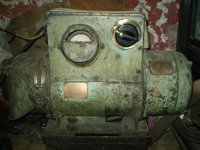Welcome Alejandro.
That's a beautiful job on the Wisconsin welder. The name plate seems to indicate 200 amps and 25 volts open circuit. Is that right?
The commutator seems hardly worn. Did you have it turned down (on a lathe), or had it just had very little use.
Please keep us posted on the motor-generator project. I always wondered why welder's were made in that style. I saw quite a few of them in the late 1940's and early 1950's in rural south Georgia. I was later told that there were several reasons. The rural power lines were not designed to handle the large unbalanced inductive load created by a transformer/rectifier, and the motor-generator created a less unbalanced load. I was also told that in the early 1900's efficient and reliable rectifiers were not available, and that a rotary converter of AC to DC (such as your motor-generator) was the only way to get DC welding current. Someone else mentioned that the inertia of the rotating motor and generature armatures stored energy that helped offset fluctuations in power line voltage.
I never got to weld with one, but someone who had used one said that the DC current was much smoother than the current from a transformer/rectifier setup.
Perhaps you or some of the other professional welders on the bulletin board can straighten me out on this.
Good luck with your project.



